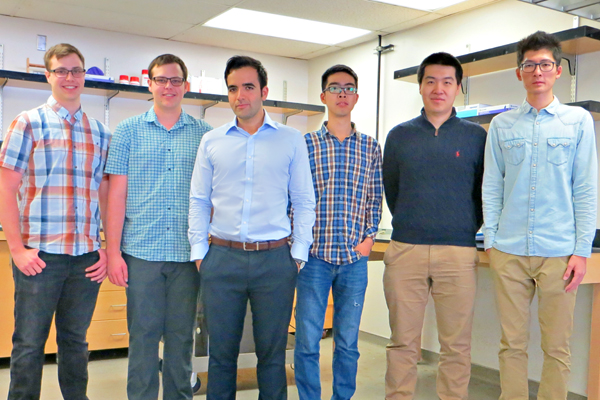He and his colleagues showed that this wearable biosensor can be used in the diagnosis of cystic fibrosis, diabetes and other diseases. The research, was done while Emaminejad was a joint-post-doctoral researcher at Stanford School of Medicine and UC Berkeley, was published in in the Proceedings of the National Academy of Sciences. The research demonstrated for the first time, a wearable, non-invasive sensor that can extract sweat at the skin’s surface and monitor in real time important biomarkers for patients. Today, he is completing his first year on the UCLA Engineering faculty and answered three questions on his research and teaching goals.

1. What can sweat tell about what’s going on inside us? And why hasn’t sweat been used much for patient monitoring and tracking?
Sweat is a rich source of physiological information and contains many biomarkers such as metabolites, electrolytes and proteins that can inform us of our health status.
Sweat-based monitoring has a huge potential to facilitate non-invasive and continuous monitoring of individuals in a wearable format, such as a smartwatch. For robust analysis we need a few droplets of sweat on-demand, which is not really accessible unless we exercise or lock ourselves in sauna!
In the work that just came out, we demonstrated a platform that can stimulate sweat glands to produce sweat with the aid of an electrical current.
In other words, they don’t have to work up a sweat, or feel discomfort to get at this valuable source of physiological information. This is an unprecedented opportunity, because now a previously inaccessible source of information has been made available for real-time monitoring.
2. What is the long-term vision for your research?
The Interconnected and Integrated Bioelectronics Lab (I²BL) was established to bridge the gap between the two worlds of Internet of Things and personalized medicine, through the development of an ecosystem of integrated and interconnected mobile, wearable and in-vivo health monitoring platforms.
These platforms facilitate the analysis of biomarker content in various human biofluids such as blood, sweat, saliva and urine, in combination with continuous measurement of physiological signals to provide a comprehensive and dynamic view of our health states.
Realizing this vision requires resolving major bottlenecks from various fronts, and we work closely with experts in biology, medicine and data science to optimize our efforts toward high impact applications. In that regard, UCLA is the perfect place for leading this collaborative research program, given the excellent synergy between the engineering and medical schools.
3. You’re teaching a class this spring quarter of your own design (EE 279 AS Micro- and Nanoscale Biosensing for Molecular Diagnostics) based on one that you co-developed and taught while a graduate student and post-doc. What will it cover, and what do you hope students get out of it?
I believe to exponentially amplify our efforts toward achieving our research vision, it is crucial to also focus on raising the next generation of researchers who themselves can take the lead in resolving the challenges ahead.
The goal of this course is for students to appreciate the interface of biology and engineering and to be equipped with the critical thinking and problem solving skills necessary to evaluate and propose solutions for today’s most pressing biosensing problems.
Image: Wearable sensor developed by Emaminejad and colleagues. Courtesy: Sam Emaminejad.
